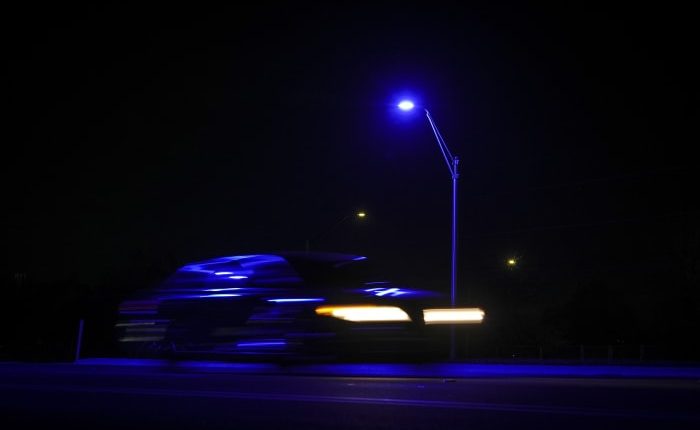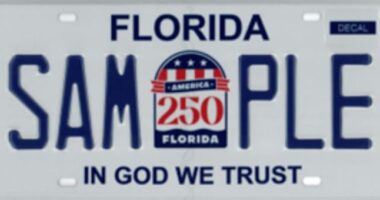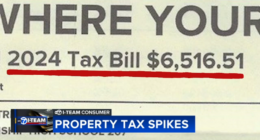Share this @internewscast.com

ORLANDO, Fla. – By now, you’ve probably spotted at least one streetlight turning a blueish-purple hue while walking or driving in the evening.
No, they are not intended to be that color. Although the lights still fulfill their intended function, there is a manufacturing defect that has recently been identified, as stated by Duke Energy and Acuity Brands, the manufacturers of the lights.
The issue has been identified in a small percentage of American Electric Lighting fixtures containing components that have not been available for sale for several years, according to a news release from Acuity.
WHAT’S HAPPENING TO THE LIGHTS?
Acuity said it is due to a “spectral shift caused by phosphor displacement” usually seen years after installation.
It’s a defect that’s unique to LED lighting.
It’s important to note that LED lighting generally tends to be more durable with superior quality compared to other types of lighting. However, LED lighting does not naturally emit white light, according to Scientific American.
As such, the white LEDs drivers typically see on the roadway aren’t actually white; they’re often some mix of red, blue and green to make them appear white.
Manufacturers can use blue LEDs and coat them with phosphor — a substance that helps emit light. The phosphor can absorb some of the blue wavelengths so that only the red and yellow ones come out, which makes the white light that streetlights primarily shine.
But in this case, the phosphor coating has peeled away from the bulb, which exposes the blue light underneath and causes the streetlights to appear purple.
ARE THEY DANGEROUS?
According to Acuity, the lights don’t pose a major threat to drivers.
“The light output is in no way harmful or unsafe. As always, we stand behind the quality of our products, and we have been proactively working with customers who have experienced the issue to address any concerns,” Acuity said.
However, Scientific American reports that purple streetlights may be dimmer and could possibly worsen a driver’s ability to see in finer detail along the roadway, as humans naturally lack blue-sensitive cones in the center of their retinas.
In addition, the purple lights may make it harder to differentiate between different colors, which doesn’t help drivers traveling at night.
As such, it’s suggested that drivers remove sunglasses and blue-light-filtering glasses when it’s dark out.
WHAT’S BEING DONE?
Last year, the Florida Department of Transportation told News 6 it was working with the manufacturer on the replacement of the lights, an issue they said is “being experienced not just here in Florida, but nationwide.”
In fact, reports about the shifts have popped up in places like Utah, Texas, Massachusetts, Canada, and even Ireland.
The FDOT also said that while the lights are not the “desired color,” they still provide intended safety benefits.
Around the same time, Duke Energy said it believed that the issue affected around 2,000 lights in their service territory in Florida.
“We have been upgrading many of our older, less efficient lights with LED lighting over the last few years, and plan to continue this transition in the years ahead.
While the vast majority of our LED lighting performs very well in communities across the state, we have identified a small pocket of LED lights in our service that have turned from the standard white color to a deep purple color. The change in color is due to manufacturer defect that was recently identified and is being addressed. The defect causes the color of the light to gradually turn purple. The light otherwise continues to work.”
Duke Energy
A Duke Energy spokesperson updated News 6 this past winter, saying all purple lights reported to the company so far had been replaced or repaired.
“However, as more purple lights are identified or reported, we continue to repair them as quickly and safely as possible,” the spokesperson added.
HOW CAN I REPORT A PURPLE STREETLIGHT?
Residents can request a street light repair by visiting their online street light repair tool.
Florida Power & Light said in a statement that customers can report streetlights displaying purple color by calling 1-800-4-OUTAGE.
“We are aware that some LED streetlights are emitting a purple hue rather than the standard white light. Most importantly, these streetlights are safe and will not impact visibility. The purple hue is the result of a manufacturer defect and is impacting streetlights nationwide. We are working with the manufacturer to replace the affected lights as the required parts become available.
We apologize for any inconvenience and appreciate our customers’ patience as we work to correct this issue. FPL remains committed to continuously improving the service we provide our customers.”
Florida Power & Light
Get today’s headlines in minutes with Your Florida Daily:
Copyright 2023 by WKMG ClickOrlando – All rights reserved.










